Language Revival Around the World
Languages are more than just tools for communication. They reflect so much culture, history, and identity. Yet, according to UNESCO, nearly half of the world’s 7,000 languages are at risk of disappearing in the coming decades. As globalisation pushes dominant languages to the forefront, countless indigenous and minority languages face extinction. In response, language revival campaigns from communities and governments around the world are working tirelessly to preserve their threatened languages.

Why Language Revival Matters
When a language dies, it takes with it a unique worldview, oral traditions, ecological knowledge, and cultural expressions. Historical sources in those languages become locked away, and the wealth of knowledge they hold is extremely difficult to uncover again. Language revival is not simply a cultural mission. It’s also a social and political one, and an act of reclaiming identity, dignity, and heritage.
Successful Language Revival Efforts
In New Zealand, the revival of Māori is a powerful example of how community-led efforts and government policy can work together. Since the 1980s, Māori immersion schools (kura kaupapa Māori), broadcasting in Māori, and the official recognition of Māori as a national language have contributed to a growing number of fluent speakers. The phrase “te reo Māori” (the Māori language) has become a symbol of national identity and pride.

It’s estimated that around 30% of New Zealanders speak Māori, and 25% can speak it as a first language. This is thanks to the hard work of campaigners like Hana Te Hemara, who campaigned for active recognition of te reo Māori and for it to be taught in schools across New Zealand. In recent years, there have even been calls to change New Zealand to its Māori name of Aotearoa and start the process of restoring Māori place names for towns and cities.
Similarly, Welsh has seen a resurgence too. Bilingual education, media presence, and government initiatives have significantly increased the number of Welsh speakers. Welsh is now a required subject in English-medium schools, and there are a growing number of schools that teach all subjects in Welsh. Signs on public roads are bilingual, and communications from hospitals and energy providers are available in Welsh. As of the end of September 2024, 27.7% of the population are able to speak Welsh. This is up from a century ago when it was considered endangered. At one point, it was even outlawed when Wales was under English rule. Today, the Welsh Government has a goal of 1 million Welsh speakers by 2050 and is also working towards the revival of more Welsh place names after the change from Brecon Beacons back to the original Welsh name of Bannau Brycheiniog.
Grassroots Movements and Digital Tools
Not all efforts are lucky enough to have government backing. In the US, the Wôpanâak Language Reclamation Project is revitalising the Wôpanâak language, which had not been spoken fluently for over a century. Through community workshops, language classes, and even immersion schools, the project has enabled new generations to speak Wôpanâak once more.
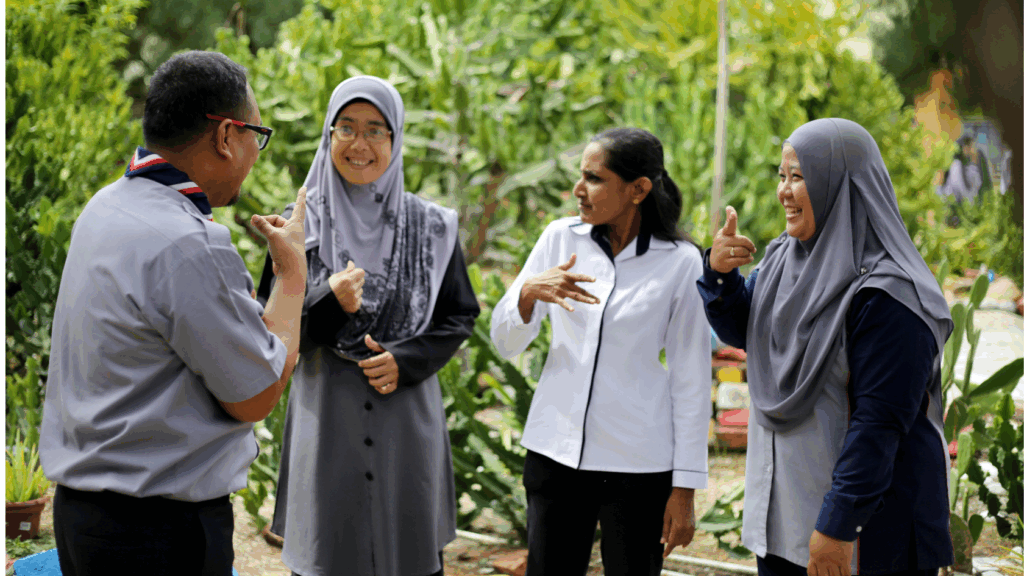
Digital tools are playing an increasing role as well. The Endangered Languages Project, supported by Google and the Alliance for Linguistic Diversity, is an online resource for documenting, sharing, and teaching endangered languages. Even language-learning apps now offer courses in Irish, Hawaiian, Catalan, and Navajo. This means that endangered languages more accessible to more people than ever before.
Challenges Ahead
Despite these successes, language revival remains challenging. It requires long-term commitment, resources, and often a change in societal attitudes. Reviving a language is not simply about teaching vocabulary. It’s about creating environments where the language can be lived and loved daily.
Language revival is a testament to resilience and cultural pride. Whether it’s the revival of Māori in New Zealand or Wôpanâak in the United States, these efforts show that languages on the brink can be brought back and thrive once again. By supporting language preservation and revitalisation initiatives, we help ensure that the world’s linguistic and cultural diversity thrives for generations to come.
Do you want to translate your content into rare languages? Contact our team today! Check out our social media pages for more language-related content as well!
Linguist Spotlight Round-Up
Over the past month, we’ve been shining the linguist spotlight on some of the incredible freelance linguists who make our work possible!
From Mandarin to Friulian, software to fine art, and funny phrases to heartfelt career stories, our linguist spotlights have given us a behind-the-scenes look at the people, languages and lived experiences that shape high-quality translation.
A truly global community
One of the most inspiring things about our freelance network is its diversity. Over the course of one month alone, we heard from linguists based in France, Italy, China, Spain and beyond – each bringing their own cultural insight and linguistic nuance to the table.
Their specialisms ranged from luxury marketing to technical translation, indie games to academic research. And yet, they all shared a deep passion for language, communication and connection.
The paths that brought them here
Every linguist has a story. Echo started out tutoring English before going full-time as a freelance translator (while pregnant with her second child!). Mercedes got her start subtitling films in London. Basel was inspired by his mother’s English teaching, and Laura returned to translation after exploring several other roles.
Whether they stumbled into the profession or pursued it with purpose, one thing’s clear: being a linguist often means carving your own path.
Thoughts on the future
It’s no surprise that AI and machine translation came up more than once. While opinions vary, our contributors agreed on one thing – the future of translation lies in balance. Technology is here to stay, but human creativity, empathy and cultural know-how will always matter, especially in fields where nuance is key.
Favourite phrases and language quirks
We couldn’t wrap up without sharing a few more of our favourite linguistic gems…
- From Arabic: تقبرني (taqburni) – “May you bury me.” A dramatic but affectionate way of saying “I love you so much I can’t bear to live without you.”
- From Spanish: Estar en la edad del pavo – “To be in the turkey age.” A very visual way to describe the awkwardness of adolescence.
- From Chinese: 啊,真香!(ā, zhēn xiāng!) – “Ah, this smells/tastes so good!” A viral expression used when someone ends up loving something they initially refused.
- From Friulian: No varìn migo di lassâsi come cjans? – “Are we really going to part like dogs?” Perfect for persuading your friends to stay for one more drink.
Thank you!
We’re so grateful to all the linguists who took the time to share their stories with us this month. Whether you’re a client, a fellow translator or just curious about languages, we hope you’ve enjoyed getting to know the people behind the words.
Don’t worry if you missed our linguist spotlight posts – you can head over to our LinkedIn to check them out!
We love working with amazing linguists from all over the world. Got a translation project coming up? Contact us – we’d love to work with you!
Linguist Spotlight – 25th April 2025
For our final linguist spotlight post of the month, we’re shining a light on four more of our fantastic freelance linguists: Basel, Laura, Echo, and Mercedes. Working across Arabic, Italian, Chinese, Spanish, and more, their stories remind us of the passion and precision behind great translation. Read on to hear about their career journeys, language tips, and some of their favourite cultural quirks.
Basel
Basel is a talented Arabic linguist who translates both from and into English. His areas of expertise range from fine art and history to social media and marketing. A lifelong language enthusiast, Basel traces the roots of his career back to his mother, an English teacher. “From a young age, I saw her speaking English and thought – I want to do that too. It felt like opening a door to the world.”
When he first moved to France, Basel tackled a new linguistic challenge: French. “When I first arrived, I started listening to podcasts and TV in French, even if I didn’t understand much. With help from my teacher and some personal effort, I now understand almost everything!”
Asked about the future of the industry, Basel sees a hybrid path ahead. “The industry is moving towards more collaboration between human linguists and technology. Machine translation is widely used, but those who want quality content increasingly understand the value of human input.”
Fun facts from Arabic:
- Hard to translate? Popular sayings and socially constructed mottos are very difficult to render well in English.
- Interesting language fact: Arabic uses so many prefixes and suffixes that a single word can form a complete sentence. For example, كتبتها means “I wrote it”.
- Funny phrase: تقبرني (ta’burni), common in the Levant, literally means “may you bury me”, but is actually an affectionate phrase expressing deep love – often from mothers to children.
Laura
Laura is a multilingual translator based in the UK, working mainly between English and Italian, with a soft spot for websites. She also translates from Russian and has a background in German. Her real mother tongue? Friulano – a Romance language spoken in the northeast of Italy. “It’s still my favourite language of all.”
Laura has had an inspiringly flexible career. “I’ve been a translator, interpreter, admin assistant, PA, business analyst… and translator again! I’m proud of being able to adapt to change, try new things, and reinvent myself.”
When it comes to the difference between translation and interpreting, Laura says: “Interpreting is fast-paced and demands quick thinking. You need to be good at letting go – you can’t beat yourself up for not thinking of a better phrasing on the spot. With translation, you have time to research and refine.”
Her advice for language learners? “Expose yourself to the language as much as possible, especially through things you enjoy like films and TV. And once you’re in the country, don’t worry about making a fool of yourself!”
As for the future, Laura offers a thoughtful perspective: “I probably wouldn’t pursue a translation degree in today’s climate. I’d recommend specialising in another field, and adding languages as a valuable extra.”
Fun facts from Italian (and Friulano!):
- Hard to translate? The word simpatico doesn’t quite translate – it means someone who is pleasant, funny, and nice all in one. Russian has a similar word, симпатичный (simpatichnyi), which can mean cute or nice.
- Funny phrase: In Friulian, at the end of a night out, you might say No varìn migo di lassâsi come cjans? – “Are we really going to part like dogs?” It means: one more drink before we go!
Echo
Echo has been a freelance Mandarin and Cantonese translator since 2009, working on everything from luxury branding to government initiatives. Based in China, she’s a native speaker of both Mandarin and Cantonese and specialises in creative, culturally sensitive content.
Her language career began with online tutoring in 2006. “Eventually, I offered editing and translation services too. One client, Dallas, became a regular and kindly introduced me to a whole network of freelance translators. (He’s now known as the brilliant mind behind GT4T!)” With regular work and a growing family, Echo made the leap to full-time freelancing in 2009 – and hasn’t looked back since.
Echo has interpreted once – “at a trade fair in Germany, back in 2017” – but prefers translation, which lets her work at her own pace. “Both require preparation and creativity. But interpreting, especially live, is definitely more challenging for me!”
For language learners, her advice is simple: “Immerse yourself daily – listen, speak, and watch things slightly above your level. Don’t be afraid to make mistakes. I’ll take this advice myself when I finally try to learn French again!”
Looking ahead, Echo sees technology playing a bigger role. “AI tools will grow in use, but human translators will remain essential for capturing nuance and cultural depth.”
Fun facts from Chinese:
- Hard to translate? 缘分 (yuán fèn) – a concept of fated connection. There’s no exact English equivalent.
- Interesting language fact: Written Chinese is logographic, so it remains consistent across dialects even if spoken Mandarin and Cantonese are very different.
- Funny phrase: 啊,真香! (ā, zhēn xiāng!) means “Ah, this smells so good!” It’s used humorously when someone changes their mind and ends up loving something they originally rejected – a bit like “Okay, fine, I actually love this!”
Mercedes
Mercedes is a freelance translator and editor working between German, English and Spanish (Spain). She specialises in software localisation and technical translation – and she loves diving into all things tech.
She got her start in subtitling, translating film and TV in London, before joining a language services provider as a project manager. “The most rewarding part of my job has always been meeting people from all over the world and learning about such a wide range of topics.”
If she could instantly master another language? “Chinese – without a doubt. It’s so commercially relevant, and I’d love to be able to connect with that part of the world.”
Her advice for language learners is refreshingly simple: “Don’t feel silly. Own your mistakes and have fun. Enjoying yourself is half the battle.”
Mercedes sees a future where machine translation and AI are the norm, but not the whole story. “There will still be a real need for human insight – especially in areas like medtech, marketing and indie games. Clients who value cultural nuance will keep turning to real people.”
Fun facts from Spanish:
• Hard to translate? Estar en la edad del pavo – literally “to be in the turkey age”! It’s used to describe that awkward, emotional teenage phase when you’re figuring everything out.
• Funny phrase: Estar como una cabra – “to be like a goat”. It means someone’s acting totally wild or silly… in the most entertaining way!
We’re incredibly proud to work with such talented, passionate linguists from around the world. Need help with your next translation project? Get in touch – we’d love to hear from you.
Linguist Spotlight: 18th April 2025
This week, we’re shining the linguist spotlight on three more brilliant linguists who bring curiosity, cultural sensitivity, and a love of language to every brief. Whether they’re translating complex IT materials or marketing content with a twist, these professionals are passionate about delivering work that truly resonates.
Eduan
Meet Eduan, a Brazilian Portuguese freelance translator and reviewer with a specialisation in technical content, IT, gaming, and general texts. With a background in computing and a flair for language, Eduan helps businesses communicate with clarity and natural fluency across borders.
His journey into translation started at the Federal Institute of Education, Science and Technology of Rio Grande do Sul (IFSUL), where he studied computing. Over time, his interest in English grew – and as his language skills deepened, he discovered that translation was the perfect blend of his tech background and creative side. He now balances technical expertise with linguistic finesse, and is currently adding Japanese to his repertoire after spending two years living in Tokyo.
When asked what a typical day looks like, Eduan says experience has made the work flow smoothly – “as long as the client provides the correct instructions, it’s just fun!”
Looking ahead, Eduan sees AI as a helpful ally in streamlining workflows and boosting productivity. But for him, the heart of good translation still lies with the human touch: “AI can assist, but it can’t replicate cultural sensitivity or context. It’ll keep evolving, but humans are still essential for tone and quality.”
Eduan also shared some fun language facts and experiences:
- A phrase that doesn’t translate well: Ficar com a pulga atrás da orelha – literally “to have a flea behind your ear,” meaning to be suspicious.
- An idiom that makes no sense in English: Chutar o balde – literally “kick the bucket,” but it actually means to give up or go wild.
- Ever mixed up languages? Not really – Eduan keeps things pretty clear, though gaming lingo sometimes sneaks into his everyday speech!
Ingrid
Say hello to Ingrid, a French linguist who translates and reviews from English into French, with a special focus on IT, marketing, and medical content.
Ingrid’s linguistic journey spans continents – from studying in Australia to completing her PhD in the US. After returning to France, she taught English for three years before deciding that the classroom wasn’t quite her calling. Wanting more flexibility and independence, she made the leap into freelancing – and quickly found her feet as a professional translator.
While Ingrid primarily focuses on technical and marketing texts, she occasionally receives more unexpected assignments. One particularly memorable project involved translating a website for adult products – “quite… interesting and fun!” she recalls.
Her tool of choice? SDL Trados Studio. “It’s not as popular as it once was,” she says, “but to me, it’s still the best.”
Like many in the field, Ingrid has noticed changes brought on by AI. “It’s actually rather scary. Workloads have decreased, and tools like DeepL are very strong. But I still believe machines will never fully replace human translators – there’s a touch of nuance and emotion they just can’t reach.”
Ingrid’s favourite language quirks include:
- A word she loves: Her children’s names – Loé (Hawaiian) and Miyo (Japanese). “They’re not French at all – the names, not my kids!”
- A beautiful untranslatable: Komorebi – the Japanese word for sunlight filtering through trees.
- Ever mixed up languages? “No, I don’t think so!”
Yinli
Meet Yinli, a Simplified Chinese linguist who works across technology, science, and the humanities. With a uniquely reflective perspective, Yinli brings insight and precision to every project she takes on.
Her path to linguistics is rooted in a broad academic background – one that she sees as more connected to her work than it might appear on paper. “I don’t see myself limited to a single discipline,” she says. For her, translation is less about rigid definitions and more about exploring the layers of meaning within and between languages.
Every project, she explains, offers a chance to gain new distinctions – both technical and philosophical. Her most trusted resources? “My old friends: paper dictionaries.”
On the future of translation, Yinli offers a poetic take: “AI can help gather symbols and their outer layers, if that’s what we’re looking for. But language is more than form – it’s about resonance.”
Here are a few of her favourite thoughts on language and culture:
- A word she loves: “Brett” – “A beautiful name for a beautiful one.”
- A unique insight: “It feels as though we grow into the language that precedes us, into every word and expression, finding our place within.”
- Ever mixed up languages? “Yes, especially while typing. Different pronunciations from various languages can trip me up sometimes.”
Come back next week for more linguist spotlight content from our incredible linguists! Curious about working with our team? We’d love to hear about your project – get in touch for a quote today!
Linguist Spotlight: 10th April 2025
For this week’s Linguist Spotlight, we’re shining the spotlight on three more brilliant linguists who bring curiosity, cultural sensitivity, and a love of language to every brief. Whether they’re translating complex IT materials or marketing content with a twist, these professionals are passionate about delivering work that truly resonates.
Eduan
For our first linguist spotlight for this week, meet Eduan, a Brazilian Portuguese freelance translator and reviewer with a specialisation in technical content, IT, gaming, and general texts. With a background in computing and a flair for language, Eduan helps businesses communicate with clarity and natural fluency across borders.
His journey into translation started at the Federal Institute of Education, Science and Technology of Rio Grande do Sul (IFSUL), where he studied computing. Over time, his interest in English grew – and as his language skills deepened, he discovered that translation was the perfect blend of his tech background and creative side. He now balances technical expertise with linguistic finesse, and is currently adding Japanese to his repertoire after spending two years living in Tokyo.
When asked what a typical day looks like, Eduan says experience has made the work flow smoothly – “as long as the client provides the correct instructions, it’s just fun!”
Looking ahead, Eduan sees AI as a helpful ally in streamlining workflows and boosting productivity. But for him, the heart of good translation still lies with the human touch: “AI can assist, but it can’t replicate cultural sensitivity or context. It’ll keep evolving, but humans are still essential for tone and quality.”
Eduan also shared some fun language facts and experiences:
- A phrase that doesn’t translate well: Ficar com a pulga atrás da orelha – literally “to have a flea behind your ear,” meaning to be suspicious.
- An idiom that makes no sense in English: Chutar o balde – literally “kick the bucket,” but it actually means to give up or go wild.
- Ever mixed up languages? Not really – Eduan keeps things pretty clear, though gaming lingo sometimes sneaks into his everyday speech!
Ingrid
Say hello to Ingrid, a French linguist who translates and reviews from English into French, with a special focus on IT, marketing, and medical content.
Ingrid’s linguistic journey spans continents – from studying in Australia to completing her PhD in the US. After returning to France, she taught English for three years before deciding that the classroom wasn’t quite her calling. Wanting more flexibility and independence, she made the leap into freelancing – and quickly found her feet as a professional translator.
While Ingrid primarily focuses on technical and marketing texts, she occasionally receives more unexpected assignments. One particularly memorable project involved translating a website for adult products – “quite… interesting and fun!” she recalls.
Her tool of choice? SDL Trados Studio. “It’s not as popular as it once was,” she says, “but to me, it’s still the best.”
Like many in the field, Ingrid has noticed changes brought on by AI. “It’s actually rather scary. Workloads have decreased, and tools like DeepL are very strong. But I still believe machines will never fully replace human translators – there’s a touch of nuance and emotion they just can’t reach.”
Ingrid’s favourite language quirks include:
- A word she loves: Her children’s names – Loé (Hawaiian) and Miyo (Japanese). “They’re not French at all – the names, not my kids!”
- A beautiful untranslatable: Komorebi – the Japanese word for sunlight filtering through trees.
- Ever mixed up languages? “No, I don’t think so!”
Yinli
Meet Yinli, a Simplified Chinese linguist who works across technology, science, and the humanities. With a uniquely reflective perspective, Yinli brings insight and precision to every project she takes on.
Her path to linguistics is rooted in a broad academic background – one that she sees as more connected to her work than it might appear on paper. “I don’t see myself limited to a single discipline,” she says. For her, translation is less about rigid definitions and more about exploring the layers of meaning within and between languages.
Every project, she explains, offers a chance to gain new distinctions – both technical and philosophical. Her most trusted resources? “My old friends: paper dictionaries.”
On the future of translation, Yinli offers a poetic take: “AI can help gather symbols and their outer layers, if that’s what we’re looking for. But language is more than form – it’s about resonance.”
Here are a few of her favourite thoughts on language and culture:
- A word she loves: “Brett” – “A beautiful name for a beautiful one.”
- A unique insight: “It feels as though we grow into the language that precedes us, into every word and expression, finding our place within.”
- Ever mixed up languages? “Yes, especially while typing. Different pronunciations from various languages can trip me up sometimes.”
Come back next week for more linguist spotlight content! Curious about working with our team? We’d love to hear about your project – get in touch for a quote today!
Linguist Spotlight: 4th April 2025
At Web-Translations, we’re fortunate to work with a team of talented linguists who bring their expertise and passion to every project. Kicking off our Linguist Spotlight series for April, we’re excited to introduce three amazing linguists: Axel, Lucia, and Ángela. Throughout the month, we’ll be sharing more stories from our linguists, highlighting their journeys, insights, and favourite language facts. Let’s get started!
Axel
Meet Axel, a super versatile English and Spanish into French freelance translator who’s all about marketing, IT, and medical content.
Axel has always had a thing for languages. He even considered being an interpreter before realising he preferred the life of a project manager and translator. His days? Non-stop. Most of his work’s due within 24 hours. “I start with overnight requests and knock out the quick stuff first. I hate procrastinating.”
One of Axel’s biggest challenges? Tackling a massive website localisation project early on – tens of thousands of words on a tight deadline. “I pulled a few all-nighters, but the client loved it.”
When it comes to AI, Axel sees it as a handy tool but keeps his guard up. “AI makes mistakes, just like people. You can’t rely on it completely.”
- Favourite word: “Tatsumaki” (Japanese for tornado). Axel just loves how it sounds.
- Interesting fact: Japanese has no plurals or subjects in sentences. It’s all about context: poetic and open to interpretation.
- Funny phrase: French: “Y’a pas le feu au lac” (The lake isn’t on fire). Basically, “No need to rush.”
Lucia
Now, let’s talk about Lucia, a freelance translator handling English, French, and Spanish into Portuguese (Brazilian and European). Her expertise? Basically everything from IT and marketing to medical instrumentation and gas & oil.
Lucia actually started out in Statistics but quickly realised it wasn’t her thing. Teaching English to kids sparked her passion for languages, and she’s been translating since 1990.
Her daily routine? Pretty chilled. She’s got pets to feed, breakfast to enjoy, and sometimes a cosy coffee shop to work from. When she’s not translating, Lucia’s out walking her dog, playing the piano, or squeezing in a yoga or dance session.
Toughest project? Translating for an oil and gas company. She had to dive deep into material properties and chemical reactions. “It required super careful, detailed research.”
Lucia’s noticed AI is changing the game. “People are trying to translate themselves with AI, but that’s not the best approach. Humans still need to check and polish everything.”
- Favourite word: “Resilient” / “Resiliente” (in Portuguese). It just feels like her.
- Interesting fact: Living in both Brazil and Portugal, Lucia’s noticed tons of differences in language use – especially when it comes to formality.
- Funny phrase: In Brazil, “Show de bola!” means something’s awesome. In Portugal, double negatives are common, like “Não seria pior se…” (It wouldn’t be worse if…). It’s a way of suggesting something’s actually a good idea!
Ángela
Meet Ángela, a Spanish freelance translator and subtitler working from English and French into Spanish. She’s all about marketing, tourism, and beauty and cosmetics.
Ángela’s journey started at 16 when she found out Translation and Interpreting was a real university degree. Her passion for languages made it an easy choice, and she hasn’t looked back.
Morning person alert! Ángela gets her best work done early, fuelled by coffee and motivation. After lunch, she keeps going until the afternoon, then hits the gym or enjoys a long walk by the river.
The trickiest project she’s tackled? An IT marketing ebook about cybersecurity – super technical but also creative. “It was tough, but my background in IT-cybersecurity texts made it a win.”
Ángela’s take on AI? It’ll boost productivity but risks creating dull, soulless texts – especially in her creative niches.
- Favourite word: “Chouette” (French for “owl” or “nice”). It’s one of the first words she learned in French, and she loves how it sounds.
- Interesting fact: Papua New Guinea is home to over 800 different languages, which blows her mind.
- Funny phrase:
Spanish: “Eres más pesado que un collar de calabazas.”
Literal translation: “You’re heavier than a necklace made of pumpkins.”
This funny phrase is used to describe someone who’s especially annoying or persistent – like a cumbersome, heavy necklace.
Check back next week for our next Linguist Spotlight to learn more about our talented translators! Want to work with our expert team? Our team can handle almost any project! Contact us for a quote today!
Women in Translation: Celebrating Their Impact on Literature and Culture
For Women’s History Month, we’ve been showcasing the remarkable contributions of women in translation on our LinkedIn page. Translators do far more than simply convert words – they bring entire cultures, stories, and ideas to new audiences. Central to shaping our understanding of world literature, women have often played a crucial yet overlooked role.
Women are Pioneers in Translation
Women translators have long been instrumental in bridging linguistic and cultural divides. Some notable figures that we mentioned on LinkedIn include:
- Constance Garnett: In the late 19th century, she introduced English readers to Russian classics by Tolstoy, Dostoevsky, and Chekhov, revolutionising how these works are perceived in the West.
- Edith Grossman: Her translations of Gabriel García Márquez’s Love in the Time of Cholera and Cervantes’ Don Quixote have been celebrated for their clarity and faithfulness to the original texts.
- Margaret Jull Costa: Known for her translations of Nobel Prize-winner José Saramago and Spanish author Javier Marías, Costa has been a key figure in introducing Iberian literature to English readers.
- Anthea Bell: Famous for her translation of the Asterix comics and literary works by Stefan Zweig, Bell’s career showed incredible versatility. She also founded the Anthea Bell Prize for Young Translators to inspire future linguists.
These pioneers are just a few of the many women whose work has reshaped our engagement with world literature. As we celebrate Women’s History Month, we invite you to discover and support the amazing women in translation.
Breaking Cultural Barriers
These women translators have made world literature accessible, fostering cultural exchange and broadening our understanding. Their work not only bridges languages but also helps foster greater empathy and awareness. Women have often faced a lack of recognition in this field, but their perseverance has ensured that important global voices are heard.
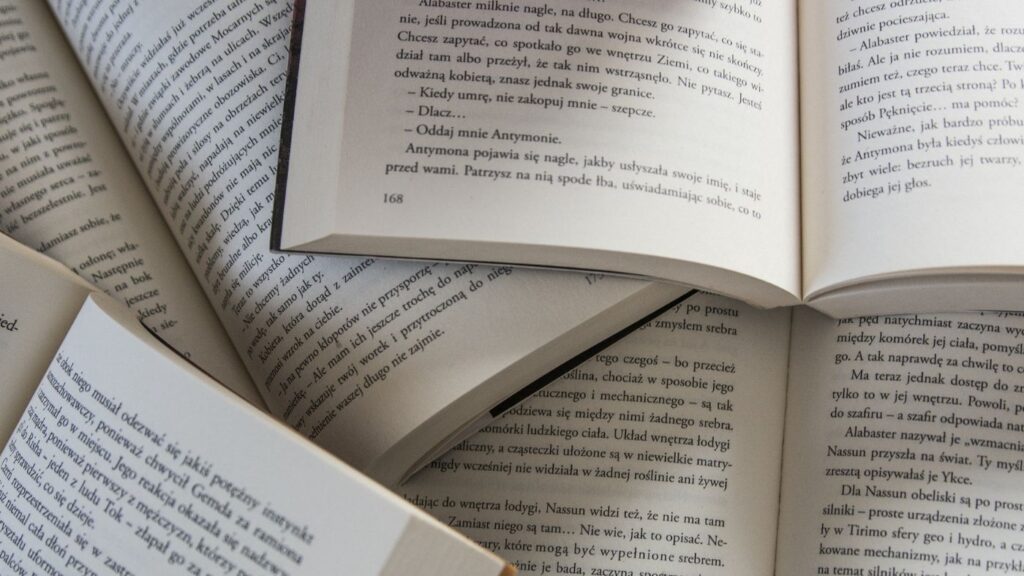
Inspiring Future Translators
Today, initiatives like the Anthea Bell Prize continue to encourage young people to explore careers in translation. The legacy of women in translation endures, keeping translation central to our engagement with global literature.
Honouring Women in Translation
This Women’s History Month, we honour trailblazers and countless women whose translation work shapes the world.
We would also like to take this opportunity to acknowledge the incredible female translators we work with every day. Their talent, professionalism, and dedication ensure that language barriers are broken, and that ideas can be shared across borders. This Women’s History Month, we celebrate their vital contributions to our projects and the wider industry.
Their work shows that translation goes beyond words – it connects cultures, preserves stories, and broadens our understanding.
If you think translation might be the best next step in developing your website or business, contact us for a quote today!
AI Translation and Website Localisation: How Open-Source Models are Transforming the Industry
Recently, Tradutor, an AI translation model, was developed to enhance European Portuguese localisation. In the rapidly evolving world of AI translation, advancements like this are continually improving accuracy and usability for businesses. Open-source models like Tradutor are expanding language access, particularly for niche or underrepresented languages, creating exciting new opportunities for website localisation. But what does this mean for businesses looking to localise their websites effectively?
Tradutor AI: A Game-Changer for European Portuguese
Tradutor is a ground-breaking AI translation model, specifically developed for European Portuguese. Historically, businesses have faced challenges in finding high-quality machine translation (MT) options for this language variant, which differs significantly from Brazilian Portuguese in vocabulary, grammar, and cultural nuances. This is where Tradutor steps in.
Developed to address these very challenges, Tradutor offers a more culturally and linguistically accurate translation than generic AI models. This advancement signals a significant shift in the AI translation landscape, expanding and improving language coverage, and delving into regional language variants with a level of precision that was previously difficult to achieve.
As AI continues to evolve, tools like Tradutor are making it possible for businesses to create more engaging, accurate, and cost-effective multilingual websites. However, it’s important to remember that while AI can improve speed and scalability, human input remains essential for ensuring cultural and linguistic accuracy.
AI & Website Localisation: A Perfect Match?
AI-driven translations are undoubtedly transforming website localisation by speeding up workflows, making it easier and faster to cater to a global audience. However, AI alone cannot guarantee the success of localisation efforts. Human expertise is still crucial when it comes to ensuring that the translations resonate with local audiences, capturing cultural context, and providing an authentic user experience. This is particularly significant, as studies show that consumers are far more likely to purchase a product or service when the website is presented in their native language.

Custom AI models, like Tradutor for European Portuguese, can enhance regional accuracy, ensuring that website content is tailored to the specific dialect and cultural preferences of the target audience. This is particularly important when dealing with markets that have distinct linguistic differences, such as the various Portuguese-speaking regions, like Portugal, Brazil, Angola and Mozambique.
For businesses targeting these diverse markets, the key to success lies in recognising the linguistic and cultural nuances between different Portuguese-speaking regions. Customised AI models for specific variations make website content more relevant and engaging, enhancing customer experience and brand perception.
The Future of AI in Localisation
Looking ahead, AI will continue to improve, and its role in localisation will only grow. However, AI models must be context-aware and tailored to specific industries and languages to truly meet the needs of businesses. This is where open-source initiatives like Tradutor can play a pivotal role. They allow companies to customise translation models to suit their requirements, ensuring that the translation process is more aligned with business goals and localised needs.
AI is undeniably a powerful tool for localisation, offering significant benefits in terms of speed, efficiency, and scalability. However, to achieve success in website localisation, businesses must combine the power of AI with the expertise of professional translators. By embracing AI advancements while ensuring cultural relevance in their localised content, companies can create more engaging, accurate, and cost-effective multilingual websites.
As AI models continue to specialise and improve, businesses will have more opportunities to leverage these technologies to enhance their website localisation efforts. With the right balance of AI and human input, the future of localisation looks brighter than ever.
At Web-Translations, we specialise in website localisation. Contact us today to find out how we can enhance your multilingual website!
Preserving Endangered Languages: The Role of Translation in Global Efforts
Languages are more than just communication tools—they carry unique cultural identities and oral traditions. Language preservation efforts help safeguard a community’s heritage, ensuring that its way of life endures for generations.
Yet, the world faces an alarming decline in linguistic diversity. Of the 7,000 languages spoken today, nearly half are expected to disappear by the end of this century. Globalisation and the dominance of a few major languages contribute heavily to this trend.
Language Preservation Strategies
Revitalisation efforts are essential in preserving these languages, and translation plays a pivotal role in these initiatives. Hawaiian and Welsh language programs show that integrating languages into daily life and education aids in language restoration. But translation technologies are also key in these efforts, helping endangered languages reach a global stage.
Tools like Google Translate and other translation software allow these languages to be understood by broader audiences. This promotes cross-cultural engagement and raising awareness about their significance. This exposure can fuel interest in preserving and learning these languages, offering new life to those that are fading.

Technology, in general, is a powerful ally in language preservation. Apps like Duolingo and AI platforms like Endangered Languages Project teach and preserve languages for future generations.
Linguists and anthropologists work with native speakers to document languages, recording oral histories, songs, and traditions. These efforts ensure that even as the number of speakers diminishes, the cultural wealth embedded in these languages is preserved. Through translation, much of this cultural heritage can be shared with the world, ensuring it is understood and appreciated across borders.
Recent initiatives, such as the UN’s Decade of Indigenous Languages (2022–2032) and funding from organisations like the Endangered Language Fund provide resources to support efforts and global partnerships. With translation at the heart of these programs, languages are not only preserved but also given new pathways to thrive in an increasingly interconnected world.
Translation is more than just a tool—it’s a lifeline for endangered languages. By making these languages accessible to a global audience, we can help preserve the richness of human diversity and cultural history for generations to come.
If you think translation might be the best next step in developing your website or business, contact us for a quote today!
Most Valuable Translator Awards 2024
We hope 2025 has started off well for you! As the New Year gets underway, it can only mean one thing… it’s time to announce our Most Valuable Translator Awards 2024!
Every January, we love taking a moment to show our appreciation for our amazing linguists by announcing our Most Valuable Translator Awards. These awards go to translators who’ve consistently gone the extra mile and have been incredibly hard working.
We can’t say enough how much we appreciate the hard work and dedication of all our freelance translators – they’re always quick to respond, consistently deliver excellent translations, and are a joy to work with. It’s such a privilege to collaborate with them, which makes it incredibly tough to pick just a few. Every single one of you gives your best, and we truly enjoy working with you. So, thank you to everyone!

That said, the Web-Translations team has been especially impressed by this group of linguists over the past year. Some have been absolute lifesavers on urgent projects, while others have consistently delivered top-notch work for our key client accounts. Their professionalism, communication skills, and translation expertise are outstanding and we would like to offer our thanks for their efforts.
Here are our most Valuable Translators for 2024….
So, please join us in congratulating the following 21 linguists (listed in alphabetical order):
- Ángela Arribas Ramírez
- Axel Couton
- Carles Hernandez
- Eduan Moraes
- Gisella Giarrusso
- Hanae Matsumura
- Ingrid Devanne
- Katrin Jarvis
- Laura Mussutto
- Lúcia Barbosa
- Marco Ramon
- Mercedes Acosta
- Nanda Weiland
- Pablo Montero Llano
- Rafael Molina Pulgar
- Thomas Carlsen
- Tine Wanning
- Ulrike Franz-Weall
- Yaotl Altan
- Yinli Zhuang
- Yookyeng Jeon
A heartfelt thank you to each and every one of you! We can’t wait to continue working with you and all our amazing linguists in the coming year. Here’s to another great year together—see you next January for the next Most Valuable Translator Awards!
Love,
The Web-Translations Team
To see our Most Valuable Translators from 2023, read here!
December Discount 2024
To celebrate the holiday season, we are offering a 15% December Discount on all translation projects! So, if you have some content that you’d like to translate, get in touch with us today for a free, no-obligation quote!
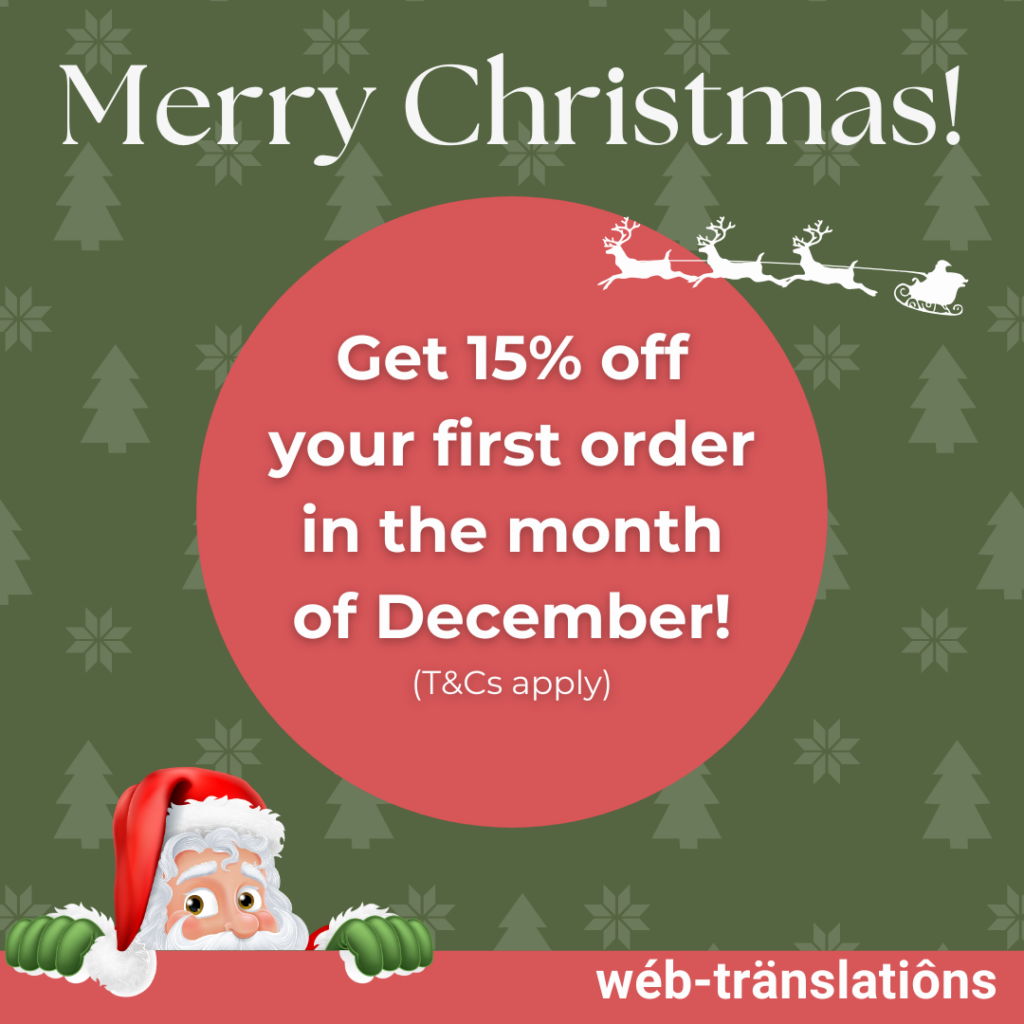
We can offer you:
- A Dedicated Project Manager
- Competitive Translation Rates
- Flexible Payment Terms
What’s more, we have a great track record working for clients in a wide range of industries. You can read all about our experience on our portfolio page! If you’d like to get to know us more, why not get in touch with our team to find out what we could do for you?
Terms:
- 15% discount will be applied to our standard rates of translation and proofreading
- Discounts will only be applied to projects exceeding our minimum charge of £60
- This discount cannot be applied to Pay-As-You-Go accounts
- This offer is restricted to the first order in December per client
- This offer cannot be combined with any other discount
- This offer will expire at 17:00 GMT, 31st December 2024
However, if your content isn’t ready for translation just yet, keep an eye out on our social media for future offers. Also, while you’re there, you can also check out our Christmas countdown – we have lots of fun content in store with our very own advent calendar!
Translation as a Journey: The Path From One Language to Another
Translation is more than just swapping words between languages; it’s a journey where each stage represents a different part of moving from the source language to the target language. After all, the Oxford English Dictionary states that the word translation can also be used to describe moving an object from one place to another.
Understanding the Terrain
The journey starts with deeply understanding the source text, much like studying a map before setting off. This involves grasping not just the words, but the cultural and contextual nuances that will guide the translation.
Charting the Course
Next comes planning the translation strategy, deciding whether to stick closely to the original or adapt it more freely. This stage is like choosing the best route on a trip, ensuring the message travels well to the new language.

Embarking on the Journey
The translation process itself is where the text moves from one language to another. The translator carefully navigates linguistic and cultural differences to ensure the final product is fluent and accurate.
Overcoming Obstacles
Challenges like untranslatable words or cultural references are the rough patches on the journey. Translators must creatively solve these issues, ensuring the translation remains true to the original while making sense in the target language.
Reaching the Destination
The journey ends with reviewing and refining the translation, much like a traveller reflecting on their trip. This final step ensures the translation is polished and ready for its audience.
Reflecting on the Journey
Just as experienced travellers make for better journeys, professional translators bring the expertise needed to navigate the complexities of translation, ensuring the final text is accurate and culturally appropriate.
In essence, translation is a complex journey requiring skill, planning, and adaptability to successfully convey a message across languages and cultures.
If you think translation might be the best next step in developing your website or business, contact us for a quote today!
What Do Translators Actually Learn at University? – Why the Professionals Are Better
For some, what translators learn at university is a bit of a mystery – here we hope to clear things up! When it comes to translation, many might assume that if you speak two languages, you’re qualified to translate between them. However, the reality is far more complex. Professional translators undergo rigorous training and studies at university. Here they learn not just the languages, but skills that ensure their translations are accurate, culturally appropriate, and effective. This training is what sets professional translators apart from those who may be bilingual but lack formal education in translation.
The Foundations of Studying Translation
At university, translators begin with deep dives into the languages they will work with. This isn’t just about fluency in speaking and writing, but about understanding the subtleties and nuances of each language. They study a range of linguistic skills including grammar, syntax, and semantics in detail, allowing them to grasp the intricate differences in how meaning is constructed. This linguistic knowledge is crucial for producing translations that accurately capture the original text’s true meaning.
Learning Cultural Competence
Language is deeply intertwined with culture, and professional translators learn this first-hand. Translators learn at university to study the cultural contexts of the languages they work with, understanding how history, society, and traditions influence language use. This cultural competence is crucial when translating texts that are intended for a specific audience, as it allows the translator to adapt the message in a way that resonates culturally, avoiding misunderstandings or offence.
Specialised Knowledge
Another key component of a translator’s university education is the acquisition of specialised knowledge in various fields. Many texts that require translation are technical, legal, medical, or scientific, each with its own jargon and conventions. Universities often offer modules or courses in these specialised areas, enabling translators to understand and accurately translate complex terminology. This specialised knowledge ensures that translations are not just linguistically accurate but are also correct within the context of the specific field.
Research Skills
Translators must also be skilled researchers. At university, they learn how to conduct thorough research to understand unfamiliar terms, concepts, or cultural references. They are trained to consult dictionaries, databases, and other resources to find the most accurate translations. This research ability is especially important in fields where language is constantly evolving, such as technology or medicine.
Studying Translation Theory and Practice
University courses in translation theory provide students with a framework for understanding the various approaches to translation. They learn about different translation strategies, such as literal versus idiomatic translation, and when to use each. Practical translation exercises complement this theoretical knowledge, allowing students to apply what they’ve learned in real-world scenarios. This combination of theory and practice helps translators make informed decisions about how to approach each translation task.

Learning the Ethics
Professional translators are also trained in the ethical aspects of their work. They learn about the importance of confidentiality, especially when dealing with sensitive documents. They are also taught to avoid conflicts of interest and to ensure that their work is impartial and unbiased. These ethical considerations are vital in maintaining the integrity and trustworthiness of the translation profession. For example, the Institute of Translation and Interpreting has an ethics guide that many professional translators refer to.
Studying the Technology
In today’s digital age, translators must be proficient in using technology. University courses often include training in computer-assisted translation (CAT) tools, which help translators manage large projects, ensure consistency, and work more efficiently. They also learn about the limitations of machine translation and how to use it appropriately, often in combination with human expertise.
Why Professionals Are Better
The comprehensive training that professional translators receive at university is what makes them the best choice for translation work. They bring not only their linguistic skills but also a deep understanding of cultural nuances, specialised knowledge, and the ability to conduct thorough research. Their grounding in translation theory, coupled with practical experience, allows them to approach each project with a well-rounded skill set that ensures the final translation is accurate, culturally appropriate, and of the highest quality.
In contrast, someone who is simply bilingual may lack the depth of knowledge required to handle complex or specialised texts effectively. Professional translators are trained to go beyond mere word-for-word translation, ensuring that the meaning, tone, and intent of the original text are fully conveyed in the target language. This level of expertise is particularly important in fields where precision is crucial, such as legal, medical, or technical translations.
In summary, while being bilingual is a great asset, it’s the comprehensive education and training that translators receive at university that truly equips them to deliver high-quality, professional translations. When accuracy and cultural sensitivity matter, turning to a professional translator is the best decision.
For all of your professional translation needs, contact us!
The Need for Translation in an International Market
In this post we will be discussing the need for translation in an international market. As the world becomes increasingly interconnected, it is becoming more and more necessary to have your business accessible in a variety of languages. Imagine going to browse a website only to find that you can’t find the information you need because it’s not in your language – it would be pretty frustrating!
If you want to send your business into the international sphere, you need to be able to appeal to an international audience, but there is no such thing as an international language. You can’t assume that your clients will understand English. Nor can you expect your customers to put all of the information they need into online translation software. Often it won’t be accurate and will create a barrier between you and your clientele.
In the sales process, you want to avoid creating obstacles between your customers and their products.
So where do I start?
Once you’ve established your target market country, your best bet is to contact a translation or localisation agency to ask them to work with you to produce the most accurate and appropriate webpage in the target language.
This of course, costs money, so it is important to weigh up the risk vs. benefits of this investment. There are ways to mitigate the cost too: for example, common website features, like a page to check out a purchase, use similar, if not the same language. In some cases, this is a potential candidate for machine translation, which is often cheaper. Machine translation, however, won’t quite cover all situations.
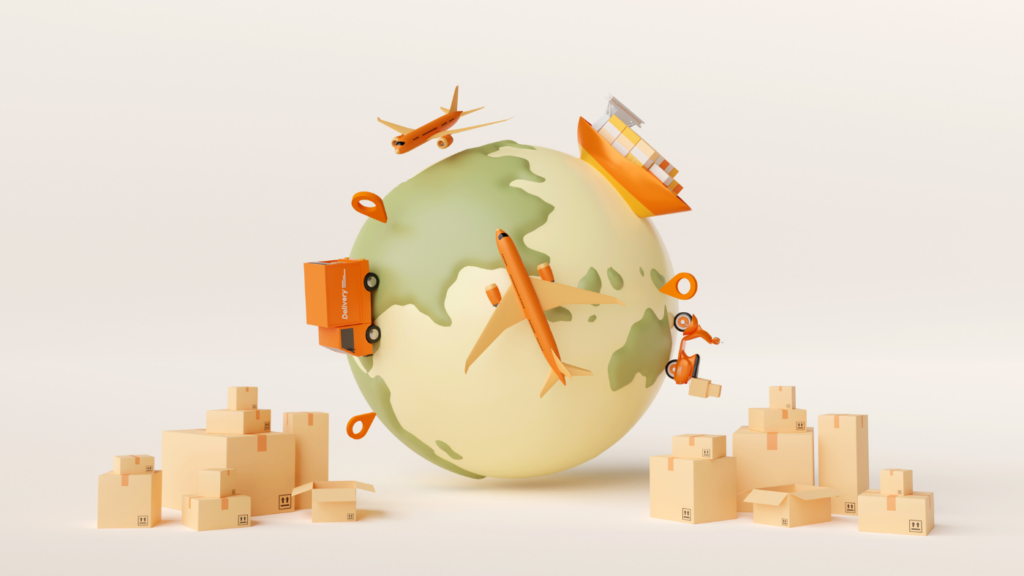
So when can’t I use MT?
Machine translation can’t take into account the context of the translations – see our post on this here. In addition, most machine translation software doesn’t account for regional language variants. For languages like Spanish where there are such a wide range of dialects across the globe, the language will need to be translated differently for each as different terminology is used.
To summarise, having your website and products translated into the target language can improve international connections and give your customers a better impression – after all, if the customers can see the effort you put into making the website easy for them to use, they are much more likely to have a better impression of your business.
Follow us on Twitter, Facebook and LinkedIn for more translation updates and news!
How Translation Audits Can Benefit your Business
At Web-Translations we offer a comprehensive translation audit service, but what exactly does that entail? Let’s take a look at how our audits work and why they’re a valuable investment for you and your business.
What is a translation audit?
A translation audit involves selecting various sections of a document or website and asking a native linguist to review them. This is done in order to ensure that your translations have both high quality and fluency. During this process, the translator provides detailed feedback on multiple aspects of your text, including fluency, word choice, grammatical accuracy, and overall coherence, ensuring your content meets the highest standards.
Why invest in one?
Ensuring that your customers feel acknowledged and catered for is absolutely essential. Errors in your website text can negatively affect customer perception. This in turn can make them feel that you’re not putting in the necessary effort. By accommodating foreign language customers, you can expand your business and make your existing customers feel truly appreciated.
The statistics back this up too. According to the CSA, 76% of customers prefer purchasing products with information in their own language. Furthermore, their research shows that 75% of respondents are more likely to buy from the same brand again if customer care is provided in their language. Clearly, catering to your customers’ language preferences can significantly enhance their experience and boost your business.
Who is it right for?
If your company has relied on Machine Translation in the past, investing in a translation audit can be incredibly beneficial. It’s a smart move to ensure your website meets the highest standards of accuracy and quality. With a thorough review by native linguists, you can identify and fix any issues, making sure your content truly resonates with your audience and reflects your brand’s professionalism.
Our audits can also help you check if your previous translations are up to scratch. Even if they were completed by a professional linguist! This can ensure that your translations are accurate and up to date – after all, translators are only human!
How does a translation audit work?
There are 3 main steps to a Translation Audit
1. Initial Review: Once you choose your audit plan, you’ll provide us with the specific pages you want reviewed—whether it’s top-level web pages or more detailed content. We then distribute these to our team of native linguists who assess the quality and accuracy of your texts.
2. Checks by Native Linguists: Our skilled native linguists thoroughly check your content, proving detailed analysis and insight into improvements they suggest. This ensures that every nuance and detail is spot on.
3. Feedback and Refinement:
If No Errors are Found: If everything is perfect and no changes are needed, great! Your text stays as it is, and you can be confident that it’s performing well.
If Changes are Required: If there are any issues, we’ll work with you to refine and correct your texts, making sure your publications are polished and effective.
Investing in a translation audit guarantees that your content is of the highest quality, significantly enhancing your credibility and strengthening your connection with your audience. By ensuring your texts are accurate, fluent, and culturally appropriate, you demonstrate a commitment to excellence that resonates with customers and sets your brand apart.
If you think a Translation Audit might be the best next step in developing your website, contact us for a quote today!
Machine Translation – What’s the Fuss About?
As you may have seen online, or on some of our other blog posts, people like to talk about how machine translation (MT) will never live up to human translation. But with the cost of human translation being so much higher, is it worth the investment?
Context is King
One of the biggest reasons to choose human translators is that they can interpret context in translations far better than machines. But just how important is context in translation?
If you imagine that one day you turned on the television to watch a crime documentary. But then realised that it was written in the tone and style of Peppa Pig – suited for young children. You would probably be very confused (and probably also a little bit amused).
This is where MT often makes errors: it doesn’t know the context that the translated text will be used in. It simply sees the words, and connects them with the correlating, often dictionary, term in the new language.
Another good example of this comes from the German language. Das Haus is used to mean both home and house in German. But to an English speaker, these are not often interchangeable terms. A human translator would have the ability to read into the context clues in the text and decide which term to use based on the way that the writing was being used. After all, in English we wouldn’t say “I’m going house.”
Knowing Your Audience
Going back to Peppa Pig for a moment – did you know that the episodes even have to be localised between different English-speaking countries? Some episodes have been removed from Australian television after problems were noticed. In this case, season 4, episode 22, “Spider’s Web,” was removed from Australian TV for depicting spiders as harmless and friendly. This is the truth in the UK – in Australia? Not so much!
A translator adapts texts or programmes for their audience, using their insight and knowledge. You have to know your audience to produce a successful translation.
Often, Machine Translation can’t do this – you can’t tell it who will be looking at the end-product. A human, however, can translate with this in mind.
So is Machine Translation Ever Useful?
Machine Translation does have a time and a place. For example, in translating a company’s internal documents where the aim of the translation is to convey the gist of the message, rather than the nuances.
Choosing the best approach for your business needs ultimately comes down to what the purpose of the translation is and the budget available. Contact us for advice and answers to your translation request queries!
Colours in Translation
As we’ve talked about on other posts, having a native linguist translate your texts is crucial to an accurate and fluent end product. However, this need for a native speaker may extend further than you expected. Have you ever considered the complexity of colours in translation?
ROYGBIV?
This is probably the rainbow as you know it: Red Orange Yellow Green Blue Indigo and Violet. But not everyone across the globe divides the colour spectrum up in the same way!
For example, in Russian these two are considered to be distinct colours:

You might be thinking: of course they are! One’s light blue and one’s dark blue! But in the Russian language, they have entirely different names! “голубой” (goluboy) to describe light blue and “синий” (siniy) for dark blue. This might seem simple enough, but if you were given a colour spectrum like the one below, would you know where to draw the line?

In situations like this you need a native speaker who does know how to tackle such challenges! Colour naming language is something that will happen more naturally for someone that is raised in the corresponding language.
Surely everyone sees the rainbow the same?
Some languages and cultures don’t have specific terms for what we would deem the ‘basic’ colours. Instead the language of the Himba people in Namibia focuses on the light and dark of colours, categorising them into four groups:
Zuzu: dark shades of blue, red, green and purples
Vapa: white, yellows
Buru: shades of green and blue
Dambu: other shades of red, green and brown.
This isn’t a one off either – the Hanunoo people of the Philippines also group their colours into entirely different categories. Their colour spectrum focuses on light vs. dark, dry vs. wet/fresh and strong vs. weak!
Colour and Symbolism
Beyond colour naming, colours often carry cultural significance. For example, in many Western cultures, the colour white is associated with purity, and by extension, weddings. Whereas in some Eastern cultures, such as in China, white symbolises mourning and death. The cultural significance of these colours is something that may be missed in a text translation by someone who doesn’t know that they can carry different meanings across the globe.
This is one example why a translator who knows the ins and outs of both the source and target language cultures is vital. A translator needs to know their audience to convey the message fully and accurately for them.
We’ve discussed the need for a native translator many times on our blog. Why not read this blog about the need for native linguists in translation?
Breaking into the International Market? Here are some pointers!
Breaking into the international market comes with several challenges: different regulations, time zones, and language barriers. But maybe your business has a reached a point where you feel ready to take the leap. Here are some tips:
How?
Moving your business into the international sphere takes careful planning and preparation.
Depending on the countries you choose to expand into, there are different factors you need to consider for each, including your customers’ language or language variant, their time zone, and their culture.

You will likely need to adapt your website beyond just translating the language. This process is called localisation, where the content is adapted to meet the cultural norms of the target audience.
It is also necessary to know the business culture and set up in your target country as each one will work slightly differently. For example, in the UAE, some businesses may require a partner local to the country due to regulations.
Why make the effort?
Thanks to digitalisation and increased internet usage, it’s as easy as ever to cross borders in seconds from the comfort of your own home.

By breaking into the international market, you allow your business to reach new markets, and therefore, new customers. This should boost sales! According to the Harvard Business Review, brands that have localised sales content are 1.5 times more likely to make a profit than businesses that don’t! It also provides your company with a competitive advantage. If you can send what the customer wants to their country, of course they’re going to choose you over a company that can’t. In addition, CSA Research reports that if aftersales services are offered in their native language, 75% of consumers are likely to consider purchasing from the same brand again.
In short, to successfully expand into a new country, you need to understand your new client base, what their likes and dislikes are, and any cultural taboos to avoid! You wouldn’t want to sell wine in a country whose culture frowns upon consuming alcohol!
At Web-Translations, we can help you translate your website to grow your business internationally. Read some of our testimonials here, and see how we’ve helped other businesses. Contact us with any queries you have!
April Fools: How It’s Celebrated
It’s April Fools Day next week! On the 1st April every year, April Fools Day is celebrated across the world. From silly jokes, to elaborate fake stories, the world has a day of fun!
It’s a bit of an unusual celebration as the reason for it is actually unknown. Some say it was originally to celebrate Renewal Festivals, dating back to Roman times. The festivals would celebrate the start of a new year, which could be due to the start of nature beginning to grow again. Others believe that the tradition started in 1582 when France started to use the Gregorian calendar rather than the Julian one. This meant that the New Year was celebrated on 1st January, rather than 1st April. It is said that many people didn’t hear about the change and continued to celebrate the New Year in April and they were consequently subject to hoaxes and jokes.
Despite not knowing the reason for celebrating and its origins, this day is often a day of funny practical jokes. In this blog, we’re going to have a look at how countries around the world celebrate this day!
Scotland
The tradition in Scotland is actually a 2-day event. 1st April is known as Hunt the Gowk Day, where gowk translates to cuckoo. The prank is, in a way, a wild goose chase. People would prank others by sending them on pointless tasks. For example, they may be asked to deliver a letter asking someone for their help. The recipient would say they would if the messenger asks someone else first. This continues until the Gowk realises that they are being pranked. The next day is known as Tailie Day. This is because one of the main jokes is pinning a sign on someone’s back saying kick me.
France
The day is called Le Poisson d’Avril in France, translating to April Fish. People eat fish-shaped chocolate and also tape fish-shaped paper to their friends’ backs. They will then shout Possion d’avril. This day started out particularly fishy as pranksters in the 15th century would stick real fish to the back of victims without them knowing.
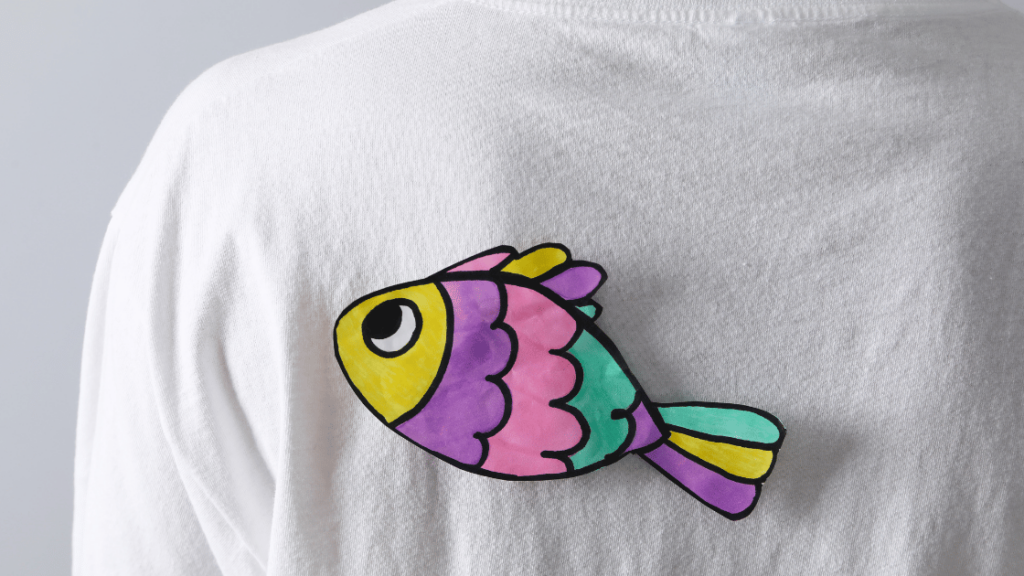
Sweden
Första April is also full of various pranks, but instead of shouting April Fools, they would shout “April, April, din dumma sill, jag kan lura dig vart jag vill!” which means “April, April, you stupid herring, I can trick you wherever I want!”
Germany
It’s also said that April Fools Day may have actually originated in Germany. In the 1860’s, a man named Gabriel Hoffman decided to play a prank on lawmakers. On 1st April, he arranged a meeting, which turned out to be a rouse. The prank was a success and the Germans adopted the tradition. However, it’s bad luck to play any pranks after 12pm.
Portugal
April Fools Day in Portugal is celebrated on the Sunday and Monday before lent. Be wary if you find yourself here at this time, as it’s a tradition to throw flour over unsuspecting victims.

USA
April Fools Day in the US usually involves news outlets and large companies being quite creative with their marketing. Most often create rather elaborate news stories. Some of them are actually quite believable.
Poland
In Poland the day is also celebrated by playing a variety of jokes and pranks. It’s known as Prima Aprillis and there is a popular Polish rhyme which says: “Prima Aprilis – uważaj, bo się pomylisz!” – which means, “April Fools’ Day, be careful, you can be wrong.”
April Fools Day is celebrated in some weird and wonderful ways around the world. This type of cultural event is important to know about when translating content, especially since different countries celebrate it in different ways.
We hope you’ve enjoyed reading about the various types of April Fools celebrations. If you’d like to read about other international celebrations, why not take a read of our Summer Solstice Festivities blog? What’s your favourite April Fools prank? Let us know via our Twitter or LinkedIn page.
Meet the Team – Alexia O’Rourke
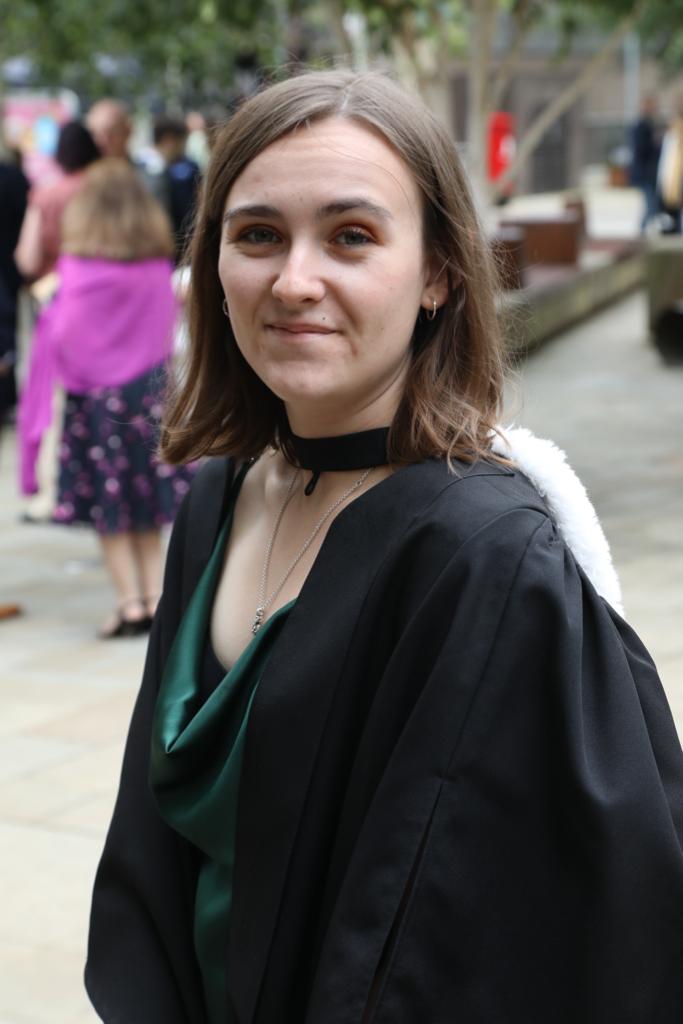
Hi everyone!
I’m Alexia and I am thrilled to be joining the Web-Translations Team as a Translation Projects Apprentice.
I have always been a bit of a languages nerd! My love for language learning was fostered at secondary school where I studied both French and German until A-Level.
At Newcastle University, I studied translation from undergraduate, through to master’s. I am proud to say that I earned a distinction in MA Professional Translation with French and Chinese. Throughout my studies, I got the opportunity to work on subjects ranging from French-Caribbean Literature to CAT tools and Localisation.
Whilst a lot of my time as a student was spent in Newcastle, I did get to spend some time abroad in China. Even though my time abroad was cut short by the pandemic, this is a time that I look back on very fondly. Living abroad gave me the opportunity to meet people from all over the globe whilst honing my language and intercultural skills. Overall, my favourite example is probably from when I spent Christmas abroad. Despite many negotiations, we couldn’t decide what to do for Christmas dinner because there was such a wide range of traditions. Eventually, we came to the conclusion that everyone liked pizza and thus, a Christmas pizza party we had!
My MA was where I really found my passion for the translation industry. Through my degree I learned some of the inner workings of the translation sphere. The idea of being able to bridge between languages and cultures to connect people is something that excites me!
Besides work, I love being outdoors and being active. I spend a lot of time running with friends! I also have a hamster called Maggie!
At Web-Translations, I’m looking forward to connecting with linguists from all around the world, and learning the skills needed to be a successful Translation Project Manager!
Interested in learning more about our team members? Read more Meet the Team blogs here!




